Aerial refueling
This article has multiple issues. Please help improve it or discuss these issues on the talk page. (Learn how and when to remove these template messages)
|
Aerial refueling, also referred to as air refueling, in-flight refueling (IFR), air-to-air refueling (AAR), and tanking, is the process of transferring aviation fuel from one aircraft (the tanker) to another (the receiver) while both aircraft are in flight.[a] The two main refueling systems are probe-and-drogue, which is simpler to adapt to existing aircraft, and the flying boom, which offers faster fuel transfer, but requires a dedicated boom operator station.
The procedure allows the receiving aircraft to remain airborne longer, extending its range or
Usually, the aircraft providing the fuel is specially designed for the task, although refueling pods may be fitted to existing aircraft designs in the case of "probe-and-drogue" systems. The cost of the refueling equipment on both tanker and receiver aircraft and the specialized aircraft handling of the aircraft to be refueled (very close "line astern" formation flying) has resulted in the activity only being used in military operations; there are no regular civilian in-flight refueling activities. Originally employed shortly before World War II on a limited scale to extend the range of British civilian transatlantic flying boats, and then after World War II on a large scale to extend the range of strategic bombers, aerial refueling since the Vietnam War has been extensively used in large-scale military operations.
Development history
Early experiments
Some of the earliest experiments in aerial refueling took place in the 1920s; two slow-flying aircraft flew in formation, with a hose run down from a hand-held fuel tank on one aircraft and placed into the usual fuel filler of the other. The first mid-air refueling, based on the development of
Similar trial demonstrations of mid-air refueling technique took place at the
As the 1920s progressed, greater numbers of aviation enthusiasts vied to set new aerial long-distance records, using inflight air refueling. One such enthusiast, who would revolutionize aerial refueling was Sir Alan Cobham, member of the Royal Flying Corps in World War I, and a pioneer of long-distance aviation. During the 1920s, he made long-distance flights to places as far afield as Africa and Australia and he began experimenting with the possibilities of in-flight refueling to extend the range of flight.[2]
Cobham was one of the founding directors of Airspeed Limited, an aircraft manufacturing company that went on to produce a specially adapted Airspeed Courier that Cobham used for his early experiments with in-flight refueling. This craft was eventually modified by Airspeed to Cobham's specification, for a non-stop flight from London to India, using in-flight refueling to extend the plane's flight duration.
Meanwhile, in 1929, a group of
The US was mainly concerned about transatlantic flights for faster postal service between Europe and America. In 1931 W. Irving Glover, the second assistant postmaster, wrote an extensive article for Popular Mechanics concerning the challenges and the need for such a regular service. In his article he even mentioned the use of aerial refueling after takeoff as a possible solution.[6]
At
Grappled-line looped-hose
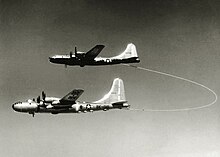
Sir Alan Cobham's grappled-line looped-hose air-to-air refueling system borrowed from techniques patented by David Nicolson and John Lord, and was publicly demonstrated for the first time in 1935. In the system the receiver aircraft, at one time an Airspeed Courier, trailed a steel cable which was then grappled by a line shot from the tanker, a Handley Page Type W10. The line was then drawn back into the tanker where the receiver's cable was connected to the refueling hose. The receiver could then haul back in its cable bringing the hose to it. Once the hose was connected, the tanker climbed sufficiently above the receiver aircraft to allow the fuel to flow under gravity.[11][12]
When Cobham was developing his system, he saw the need as purely for long-range transoceanic commercial aircraft flights,[13] but modern aerial refueling is used exclusively by military aircraft.
In 1934, Cobham had founded
During the closing months of World War II, it had been intended that Tiger Force's Lancaster and Lincoln bombers would be in-flight refueled by converted Halifax tanker aircraft, fitted with the FRL's looped-hose units, in operations against the Japanese homelands, but the war ended before the aircraft could be deployed. After the war ended, the USAF bought a small number of FRL looped-hose units and fitted a number of B-29s as tankers to refuel specially equipped B-29s and later B-50s. The USAF made only one major change in the system used by the RAF. The USAF version had auto-coupling of the refueling nozzle, where the leader line with the refueling hose is pulled to the receiver aircraft and a refueling receptacle on the belly of the aircraft, allowing high-altitude air-to-air refueling and doing away with the aircraft having to fly to a lower altitude to be depressurized so a crew member could manually do the coupling.[16]
This air-to-air refueling system was used by the
Probe-and-drogue system
Cobham's company FRL soon realized that their looped-hose system left much to be desired and began work on an improved system that is now commonly called the probe-and-drogue air-to-air refueling system and today is one of the two systems chosen by air forces for air-to-air refueling, the other being the flying-boom system. In post-war trials the RAF used a modified Lancaster tanker employing the much improved probe-and-drogue system, with a modified
Modern specialized
In January 1948, General Carl Spaatz, then the first Chief of Staff of the new United States Air Force, made aerial refueling a top priority of the service. In March 1948, the USAF purchased two sets of FRL's looped-hose in-flight refueling equipment, which had been in practical use with British Overseas Airways Corporation (BOAC) since 1946, and manufacturing rights to the system. FRL also provided a year of technical assistance. The sets were immediately installed in two Boeing B-29 Superfortresses, with plans to equip 80 B-29s.
Flight testing began in May 1948 at
The first use of aerial refueling in combat took place during the Korean War, involving F-84 fighter-bombers flying missions from Japanese airfields, due to Chinese-North Korean forces overrunning many of the bases for jet aircraft in South Korea, refueling from converted B-29s using the drogue-and-probe in-flight refueling system with the probe located in one of the F-84's wing-tip fuel tanks.
Systems
This section needs additional citations for verification. (April 2012) |
Flying boom
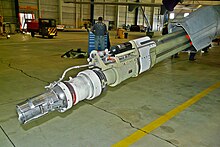
The flying boom is a rigid, telescoping tube with movable
History
In the late 1940s, General
The flying boom is attached to the rear of the tanker aircraft. The attachment is
The "flying" boom is so named because
To complete an aerial refueling, the tanker and receiver aircraft rendezvous, flying in formation. The receiver moves to a position behind the tanker, within safe limits of travel for the boom, aided by director lights or directions radioed by the boom operator. Once in position, the operator extends the boom to make contact with the receiver aircraft. Once in contact, fuel is pumped through the boom into the receiver aircraft.
While in contact, the receiver pilot must continue to fly within the "air refueling envelope", the area in which contact with the boom is safe. Moving outside of this envelope can damage the boom or lead to mid-air collision, for example the 1966 Palomares B-52 crash. If the receiving aircraft approaches the outer limits of the envelope, the boom operator will command the receiver pilot to correct their position and disconnect the boom if necessary.
When the desired amount of fuel has been transferred, the two aircraft disconnect and the receiver aircraft departs the formation. When not in use, the boom is stored flush with the bottom of the tanker's fuselage to minimize drag.
In the KC-97 and KC-135 the boom operator lays prone, while the operator is seated in the
The US Air Force fixed-wing aircraft use the flying boom system, along with countries operating F-16 or F-15 variants. The system is used by Australia (KC-30A), the Netherlands (KDC-10), Israel (modified Boeing 707), Japan (KC-767), Turkey (KC-135Rs), and Iran (Boeing 747). The system allows higher fuel flow rates (up to 1,000 US gallons (3,800 L) / 6,500 pounds (2,900 kg) per minute for the KC-135, but does require a boom operator, and can only refuel one aircraft at a time.
Probe-and-drogue

The probe-and-drogue refueling method employs a flexible hose that trails from the tanker aircraft. The drogue (or para-drogue), sometimes called a basket, is a fitting resembling a shuttlecock, attached at its narrow end (like the "cork" nose of a shuttlecock) with a valve to a flexible hose. The drogue stabilizes the hose in flight and provides a funnel to aid insertion of the receiver aircraft probe into the hose. The hose connects to a Hose Drum Unit (HDU). When not in use, the hose/drogue is reeled completely into the HDU.
The receiver has a probe, which is a rigid, protruding or pivoted retractable arm placed on the aircraft's nose or fuselage to make the connection. Most modern versions of the probe are usually designed to be retractable, and are retracted when not in use, particularly on high-speed aircraft.[citation needed]
At the end of the probe is a valve that is closed until it mates with the drogue's forward internal receptacle, after which it opens and allows fuel to pass from tanker to receiver. The valves in the probe and drogue that are most commonly used are to a
The NATO-standard probe system incorporates shear rivets that attach the refueling valve to the end of the probe.[citation needed] This is so that if a large side or vertical load develops while in contact with the drogue, the rivets shear and the fuel valve breaks off, rather than the probe or receiver aircraft suffering structural damage. A so-called "broken probe" (actually a broken fuel valve, as described above) may happen if poor flying technique is used by the receiver pilot, or in turbulence. Sometimes the valve is retained in the tanker drogue and prevents further refueling from that drogue until removed during ground maintenance.
Buddy store

A "buddy store" or "buddy pod" is an external pod loaded on an aircraft hardpoint that contains a hose and drogue system (HDU).[24] Buddy stores allow fighter / bomber aircraft to be reconfigured for "buddy tanking" other aircraft. This allows an air combat force without dedicated/specialized tanker support (for instance, a carrier air wing) to extend the range of its strike aircraft. In other cases, using the buddy store method allows a carrier-based aircraft to take-off with a heavier than usual load less fuel than might be necessary for its tasking. The aircraft would then topped-up with fuel from an HDU-equipped "buddy" tanker, a method previously used by the Royal Navy in operating its Supermarine Scimitar, de Havilland Sea Vixen, and Blackburn Buccaneers; in the Buccaneer's case using a bomb-bay-mounted tank and HDU.

The tanker aircraft flies straight and level and extends the hose/drogue, which is allowed to trail out behind and below the tanker under normal aerodynamic forces. The pilot of the receiver aircraft extends the probe (if required) and uses normal flight controls to "fly" the refueling probe directly into the basket. This requires a closure rate of about two knots (walking speed) to push the hose several feet into the HDU and solidly couple the probe and drogue. Too little closure will cause an incomplete connection and no fuel flow (or occasionally leaking fuel). Too much closure is dangerous because it can trigger a strong transverse oscillation in the hose, severing the probe tip.
The optimal approach is from behind and below (not level with) the drogue. Because the drogue is relatively light (typically soft canvas webbing) and subject to aerodynamic forces, it can be pushed around by the bow wave of approaching aircraft, exacerbating engagement even in smooth air. After initial contact, the hose and drogue is pushed forward by the receiver a certain distance (typically, a few feet), and the hose is reeled slowly back onto its drum in the HDU. This opens the tanker's main refueling valve allowing fuel to flow to the drogue under the appropriate pressure (assuming the tanker crew has energized the pump). Tension on the hose is aerodynamically 'balanced' by a motor in the HDU so that as the receiver aircraft moves fore and aft, the hose retracts and extends, thus preventing bends in the hose that would cause undue side loads on the probe. Fuel flow is typically indicated by illumination of a green light near the HDU. If the hose is pushed in too far or not far enough, a cutoff switch will inhibit fuel flow, which is typically accompanied by an amber light. Disengagement is commanded by the tanker pilot with a red light.[24]
The
Boom drogue adapter units

USAF KC-135 and
The other major difference with this system is that when contacted, the hose does not "retract" into an HDU. Instead, the hose bends depending on how far it is pushed toward the boom. If it is pushed too far, it can loop around the probe or nose of the aircraft, damage the windscreen, or cause contact with the rigid boom. If not pushed far enough, the probe will disengage, halting fueling. Because of a much smaller position-keeping tolerance, staying properly connected to a KC-135 adapter unit is considerably more difficult than staying in a traditional hose/drogue configuration. When fueling is complete, the receiver carefully backs off until the probe refueling valve disconnects from the valve in the basket. Off center disengagements, like engagements, can cause the drogue to "prang" the probe and/or strike the aircraft's fuselage.
Multiple systems

Some tankers have both a boom and one or more complete hose-and-drogue systems. The USAF
Wing-to-wing
A small number of Soviet
Simple grappling
Some historic systems used for pioneering aerial refueling used the grappling method, where the tanker aircraft unreeled the fuel hose and the receiver aircraft would grapple the hose midair, reel it in and connect it so that fuel can be transferred either with the assistance of pumps or simply by
Compatibility issues
The probe-and-drogue system is not compatible with flying boom equipment, creating a problem for military planners where mixed forces are involved.
These concerns can be addressed by drogue adapters (see section "Boom drogue adapter units" above) that allow drogue aircraft to refuel from boom-equipped aircraft, and by refuelers that are equipped with both drogue and boom units and can thus refuel both types in the same flight, such as the KC-10, MPRS KC-135, or Airbus A330 MRTT.
Strategic
The development of the
In 1958, Valiant tankers in the UK were developed with one HDU mounted in the bomb-bay. Valiant tankers of 214 Squadron were used to demonstrate radius of action by refueling a Valiant bomber non-stop from UK to Singapore in 1960 and a Vulcan bomber to Australia in 1961. Other UK exercises involving refueling aircraft from Valiant tankers included Javelin and Lightning fighters, also Vulcan and Victor bombers. For instance, in 1962 a squadron of Javelin air defense aircraft was refueled in stages from the UK to India and back (exercise "Shiksha"). After the retirement of the Valiant in 1965, the Handley Page Victor took over the UK refueling role and had three hoses (HDUs). These were a fuselage-mounted HDU and a refueling pod on each wing. The center hose could refuel any probe-equipped aircraft, the wing pods could refuel the more maneuverable fighter/ground attack types.
A byproduct of this development effort and the building of large numbers of tankers was that these tankers were also available to refuel
The USAF
Normally, all the fuel aboard a tanker aircraft may be either offloaded, or burned by the tanker as necessary. To make this possible, the KC-135 fuel system incorporated gravity draining and pumps to allow moving fuel from tank to tank depending on mission needs. Mixing JP-7 with JP-4 or Jet A, however, rendered it unsuitable for use by the SR-71, so the Air Force commissioned a specially modified KC-135 variant, the
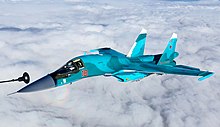
Tactical
Tankers are considered "
Operational history
Cold War
Even as the first practical methods for aerial refueling were being developed, military planners had already envisioned what missions could be greatly enhanced by using such techniques. In the emerging Cold War climate of the late 1940s, the ability for bombers to perform increasingly long distance missions would enable targets to be struck even from air bases on a different continent. Thus, it became commonplace for nuclear-armed strategic bombers to be equipped with aerial refuelling apparatus and for it to be used to facilitate long distance patrols.[32]
During the late 1950s, aerial refuelling had become so prevalent amongst the bombers operated by the US Air Force's Strategic Air Command that many, such as the Convair B-58 Hustler, would operate largely or entirely out of bases in the continental United States while maintaining strategic reach.[32] This practice was promoted to address security concerns as well as diplomatic objections from some overseas nations that did not want foreign nuclear weapons being kept on their soil.[32] In one early demonstration of the Boeing B-52 Stratofortress's global reach, performed between 16 and 18 January 1957, three B-52Bs made a non-stop flight around the world during Operation Power Flite, during which 24,325 miles (21,145 nmi, 39,165 km) was covered in 45 hours 19 minutes (536.8 smph) with multiple in-flight refuelings being performed from KC-97s.[33][34]
While development of the Avro Vulcan strategic bomber was underway, British officials recognised that its operational flexibility could be improved by the provision of in-flight refuelling equipment.[35] Accordingly, from the 16th aircraft to be completed onwards, the Vulcan was furnished with in-flight refuelling receiving equipment.[36][37] While continuous airborne patrols were flown by the RAF for a time, these were deemed to be untenable, and the refuelling mechanisms across the Vulcan fleet largely fell into disuse during the 1960s.[37] When the RAF chose to optimise its bomber fleet away from high-altitude flight and towards low-level penetration missions, bombers such as the Handley Page Victor were fitted with aerial refuelling probes and additional fuel tanks to counter the decreased range from the shift in flight profile.[38][39]
During the mid-1950s, to deliver France's independent
Korean War
On 6 July 1951, the first combat air refueling of fighter-type aircraft took place over Korea. Three RF-80As launched from Taegu with the modified tip-tanks and rendezvoused with a tanker offshore of Wonsan, North Korea. Through in-flight refueling, the RF-80s effectively doubled their range, which enabled them to photograph valuable targets in North Korea.[46][47]
Vietnam War
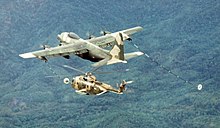
During the
The US Navy frequently used carrier-based aerial tankers like the
During late August 1970, a pair of
Middle East
During the 1980s Iran–Iraq War, the Iranian Air Force maintained at least one KC 707-3J9C aerial tanker, which the Islamic Republic had inherited from the Shah's government. This was used most effectively on 4 April 1981, refueling eight IRIAF F-4 Phantoms on long-range sorties into Iraq to bomb the H-3 Al Walid airfield near the Jordanian border, destroying 27–50 Iraqi fighter jets and bombers.[49][50] However, the Iranian Air Force was forced to cancel its 180-day air offensive and attempts to control Iranian airspace due to unsustainable rates of attrition.[51][52]
The
Falklands War
During the
On the British side, air refueling was carried out by the
Gulf War
During the time of Operation Desert Shield, the military buildup to the Persian Gulf War, US Air Force Boeing KC-135s & McDonnell Douglas KC-10As, and USMC KC-130 Hercules aircraft were deployed to forward air bases in
On 16–17 January 1991, the first combat sortie of Operation Desert Storm, and the longest combat sortie in history at that time, was launched from
An extremely useful tanker in Desert Storm was the USAF's KC-10A Extender. Besides being larger than the other tankers deployed, the KC-10A is equipped with the USAF "boom" refueling and also the "hose-and-drogue" system, enabling it to refuel not only USAF aircraft, and also USMC and US Navy jets that use the "probe-and-drogue" system, and also allied aircraft, such as those from the UK and Saudi Arabia. KC-135s may be equipped with a drogue depending on the mission profile. With a full jet fuel load, the KC-10A is capable of flying from a base on the American east coast, flying nonstop to Europe, transferring a considerable amount of fuel to other aircraft, and returning to its home base without landing anywhere else.[citation needed]
On 24 January 1991, the Iraqi Air Force launched the Attack on Ras Tanura, an attempt to bomb the Ras Tanura oil facility in Saudi Arabia. On their way to the target, the Iraqi attack aircraft were refueled by tanker at an altitude of 100 meters. The attack ultimately failed, with two aircraft turning back and the remaining two shot down.[64][65]
Helicopters
Helicopter in-flight refueling (HIFR) is a variation of aerial refueling when a naval helicopter approaches a warship (not necessarily suited for landing operations) and receives fuel through the cabin while hovering. Alternatively, some helicopters like the HH-60 Pave Hawk are equipped with a probe extending out the front can be refueled from a drogue-equipped tanker aircraft in a similar manner to fixed-wing aircraft by matching a high forward speed for a helicopter to a slow speed for the fixed-wing tanker.
Longest crewed flight record
A mission modified
Developments
- Commercial tankers are occasionally used by military forces. The Omega Aerial Refueling Services company[68] and Metrea Strategic Mobility[69] are contracted by the US Navy. In June 2023, Metrea completed the first commercial refueling of the US Air Force.[70]
- Autonomous (hands off) refueling using probe/drogue systems was investigated by NASA, potentially for use by unmanned aerial vehicles in the KQ-X program.[71]
Operators
- Colombian Air Force[72]
- French Air Force[72]
- French Navy
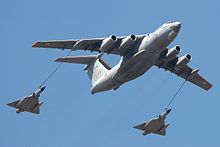

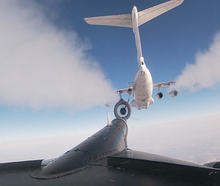
See also
- Military logistics
- Propellant depot
- Underway replenishment, the transfer of refuel and stores at sea
- List of tanker aircraft
Notes
- Instrument Flight Rules.
References
Citations
- S2CID 114942345. Archived from the original(PDF) on 21 October 2013. Retrieved 20 October 2011.
- ISBN 978-0-7190-4111-2; G.H. Pirie, Cultures and Caricatures of British imperial Aviation: Passengers, Pilots, Publicity (Manchester University Press, 2012), Chapter 4.
- ^ There is no evidence of a relationship between A.D. Hunter and the Hunter brothers.
- ^ "National Air and Space Museum image". Archived from the original on 16 April 2009.
- ^ a b History of Aviation, Part 19, 1938
- ^ Hearst Magazines (February 1931). "Wings Across The Atlantic". Popular Mechanics. Hearst Magazines. p. 190. Archived from the original on 13 March 2023. Retrieved 4 June 2016.
- ^ Flight Magazine archive, 10 January 1929
- ^ Flight Magazine archive, 3 July 1931, p. 623
- ^ Richard K. Smith. "Seventy Five Years of Inflight Refueling" (PDF). Archived (PDF) from the original on 24 August 2017. Retrieved 1 October 2013.
- ^ "Mid-air refuelling in Gander". Archived from the original on 24 March 2017. Retrieved 4 October 2013.
- ^ Bonnier Corporation (January 1947). "Gas Station In The Sky". Popular Science. Bonnier Corporation. p. 2.
- ^ "Refuelling In Flight" , Flight Magazine, November 22, 1945 Archived 5 October 2013 at the Wayback Machine close-up drawing of receiver pawl grapnel and tanker haul line projectile
- ^ "flight march – receiver aircraft – advertisements flight – 1947 – 0392 – Flight Archive". Archived from the original on 2 April 2015. Retrieved 19 November 2016.
- ^ Note – on one flight there was a high westerly wind and no need for aerial refueling
- ^ "imperial airways – 1940 – 1219 – Flight Archive". Archived from the original on 5 October 2013. Retrieved 19 November 2016.
- ^ Bonnier Corporation (August 1948). "What Can Our Bombers Do Now?". Popular Science. Bonnier Corporation. p. 79. Archived from the original on 13 March 2023. Retrieved 4 June 2016.
- ^ "flight – lucky lady – flight refuelling – 1949 – 0461 – Flight Archive". Archived from the original on 21 August 2016. Retrieved 19 November 2016.
- ^ "B-50s In Great Britain" , Flight magazine, 1 September 1949
- ^ Hallex, Steve. "Around the World in 94 Hours*". Logbook. 14 (1, 1st Quarter 2016).
- ^ "Cobham 75 :: Air-to-Air Refuelling Takes off". Archived from the original on 8 July 2011. Retrieved 17 November 2009.
- ^ Bonnier Corporation (October 1949). "Jet Refuels Like Humming Bird". Popular Science. Bonnier Corporation. p. 131. Archived from the original on 13 March 2023. Retrieved 16 May 2019.
- ^ "Meteor's 12-hour Flight", Flight, 1949, archived from the original on 8 July 2017, retrieved 13 April 2014
- ^ "50 Years of Probe and Drogue Flight Refuelling cover signed Air Chief Marshal Sir Michael Knight KCB AFC FRAES". Archived from the original on 4 March 2016. Retrieved 19 November 2016.
- ^ a b Naval Air Systems Command (1 August 2006). A1-F18AC-NFM-000 Naval Aviation Training and Operating Procedures Standardization (NATOPS) Manual. United States Department of the Navy. p. 364.
- ^ "Inflight Refueling". Zvezda JSC. Archived from the original on 16 August 2007. Retrieved 6 July 2021.
- ^ Cordesman & Kleiber 2007, p. 158.
- ^ Maj. Marck R. Cobb, "Aerial Refueling: The Need for a Multipoint, Dual-System Capability," AU-ARI-CP-87-3, Air University Press, July 1987.
- ^ note – even today there is much confusion about how this system actually worked
- ^ Christopher, Bolkcom; D., Klaus, Jon (11 May 2005). "Air Force Aerial Refueling Methods: Flying Boom versus Hose-and-Drogue". Digital Library. Archived from the original on 11 May 2009. Retrieved 27 October 2017.
{{cite journal}}: CS1 maint: multiple names: authors list (link) - ^ "Canadian military unable to refuel new jets in mid-air". Macleans.ca. 31 January 2011. Archived from the original on 14 June 2015. Retrieved 13 June 2015.
- ^ "Lockheed SR-71 Blackbird". Archived from the original on 17 March 2010. Retrieved 8 February 2014.
- ^ a b c Farley, Robert (10 June 2016). "The B-58 Hustler: America's Cold War Nuclear Bomber Blunder". nationalinterest.org. Archived from the original on 23 April 2021. Retrieved 30 March 2021.
- ^ Condor 1994, p. 42.
- ^ Knaack 1988, p. 243.
- ^ Wynn 1997, p. 154.
- ^ Wynn 1997, p. 155.
- ^ a b Brookes and Davey 2009, p. 49.
- ^ Rodwell Flight 13 February 1964, p. 241.
- ^ Windle and Bowman 2009, p. 21.
- ^ a b Gunston 1973, p. 104.
- ^ Gunston and Gilchrist 1993, p. 196.
- ^ Gunston 1973, p. 109.
- ^ Gunston and Gilchrist 1993, p. 200.
- ^ Dumoulin, André, "La dissuasion nucléaire française en posture méditerranéenne" (PDF), Les Cahiers du RMES, II (1): 5–12, archived from the original (PDF) on 13 March 2012, retrieved 18 October 2010,
(p. 5) Certes, la posture méditerranéenne ne pouvait totalement résoudre la question de l'autonomie après le largage de la bombe à gravité AN-21 puis AN-22, et il était imaginé, au pire, des vols «kamikaze» jusqu'aux cibles russes mais également des profils de vols de retour avec planification des zones de crash, avec l'abandon de l'équipage au-dessus de territoires alliés.
- ^ Gunston and Gilchrist 1993, pp. 196–197.
- ^ "History of aerial refueling: Fueling the fighters". United States Air Mobility Command. 15 April 2009. Archived from the original on 5 October 2017. Retrieved 6 July 2021.
- ^ "First USAF Flight Refueling in Combat". Archived from the original on 11 April 2017. Retrieved 6 December 2020.
- ^ "S-65/H-53A/D Sea Stallion/ H-53E Super Stallion". sikorskyarchives.com. Archived from the original on 23 March 2022. Retrieved 28 March 2021.
- ^ "Assault on Al-Wallid". Imperial Iraniasn Air Force. Archived from the original on 11 October 2017. Retrieved 9 September 2012.
- ISBN 0-946219-46-X. p. 77.
- ^ Cordesman, Anthony. "Lessons of Modern Warfare: The Iran Iraq War Chapter V" (PDF). Archived (PDF) from the original on 11 September 2009. Retrieved 4 May 2013.
- ^ Cooper, Tom. "Bombed by Blinders Part 1". Archived from the original on 6 October 2014. Retrieved 20 April 2013.
- ^ Israeli Air Force (10 October 2013). "תדלוק אווירי". Archived from the original on 7 November 2021. Retrieved 19 November 2016 – via YouTube.
- ^ "Israel's First Strike on Iran's Nuclear Facilities – Part 1 - Defense Media Network". Archived from the original on 20 November 2016. Retrieved 19 November 2016.
- ^ a b "US rejects Israeli request for tanker aircraft as Iran plans advance". 13 December 2021. Archived from the original on 13 December 2021. Retrieved 13 December 2021.
- ^ Bergman 2018, p. 306.
- ^ "The Falkland Islands: A history of the 1982 conflict." Royal Air Force, 29 April 2010. Archived 18 March 2007 at the Wayback Machine
- ^ Darling 2007, pp. 116–117.
- ISBN 978-1-84799-237-6(p.119)
- ^ "Narrative of RAF Contribution to the Falklands Campaign." The National Archives, Retrieved: 20 April 2014.
- ^ Bull 2004, p. 84.
- ^ "Factsheets: 2nd Bomb Wing History" Archived 26 September 2009 at the Wayback Machine. Barksdale Air Force Base, United States Air Force. Retrieved 19 September 2011.
- ^ Boeing B-52 evolves again with guided weapons launcher Archived 20 August 2019 at the Wayback Machine – Flightglobal.com, 15 January 2016
- ^ Woods, Kevin (May 2008). Iraqi Perspectives Project Phase II Um Al-Ma'arik (The Mother of All Battles): Operational and Strategic Insights from an Iraqi Perspective (First ed.). Institute for Defense Analysis. p. 199.
- ISBN 1557502811.
- ^ "The Plane that Flew for 62 Days and the T-Bird that Saved the Day". 29 July 2008. Archived from the original on 20 November 2016. Retrieved 19 November 2016.
- ^ "Endurance Test, Circa 1958". 3 January 2008. Archived from the original on 5 April 2016. Retrieved 19 November 2016.
- ^ "Omega Air Refueling". Archived from the original on 12 May 2015. Retrieved 19 November 2016.
- ^ "Metrea Strategic Mobility". Metrea. Archived from the original on 31 January 2023. Retrieved 31 January 2023.
- ^ Trevithick, Joseph (12 July 2023). "Private Aerial Refueling Tanker Has Gassed Up An Air Force Plane For The First Time". The Drive. Retrieved 16 July 2023.
- ^ "Ares". Archived from the original on 23 February 2012. Retrieved 19 November 2016.
- ^ a b c d e f g h i j k l m n o p q r s t u v w x y z aa ab ac ad ae af ag "World Air Forces 2020". Flightglobal Insight. 2020. Archived from the original on 10 December 2019. Retrieved 1 April 2020.
- ^ Jennings, Greg (14 January 2020). "Egypt demonstrates aerial refuelling for combat aircraft". Janes.com. Archived from the original on 6 September 2020. Retrieved 6 July 2021.
- ^ McLaughlin, Andrew (22 January 2018). "Indonesia seeks new heavy air refuelling tanker". ABDR. Archived from the original on 3 April 2018. Retrieved 6 July 2021.
- ^ Sharma, Soumya (17 October 2022). "Portuguese Air Force's first KC-390 aircraft arrives in Portugal". Airforce Technology. Retrieved 16 September 2023.
Bibliography
- Bull, Stephen. Encyclopedia of Military Technology And Innovation. Santa Barbara, California: Greenwood Publishing Group, 2004. ISBN 978-1-57356-557-8.
- Brookes, Andrew and Chris Davey. Vulcan Units of The Cold War (Osprey Combat Aircraft: 72). Oxford, UK: Osprey Publishing, 2009. ISBN 978-1-84603-297-4.
- Condor, Albert E. Air Force Gunners (AFGA): The Men Behind the Guns, The History of Enlisted Aerial Gunnery, 1917–1991. Nashville, Tennessee: Turner Publishing, 1994. ISBN 978-1-56311-167-9.
- Darling, Kev. Avro Vulcan, Part One (RAF Illustrated). Vale of Glamorgan Wales, UK: Big Bird Aviation Publication, 2007. ISBN 978-1-84799-237-6.
- Gardner, Brian (1984). "Flight Refuelling... The Wartime Story". ISSN 0143-5450.
- Gunston, Bill. Bombers of the West. New York: Charles Scribner's and Sons; 1973. ISBN 0-7110-0456-0.
- Gunston, Bill and Peter Gilchrist. Jet Bombers: From the Messerschmitt Me 262 to the Stealth B-2. Osprey, 1993. ISBN 1-85532-258-7.
- Knaack, Marcelle Size. Post-World War II Bombers, 1945–1973. Washington, D.C.: Office of Air Force History, 1988. ISBN 978-0-16-002260-9.
- Rodwell, Robert R. "The Steel in the Blue: Last Week's Glimpse of the V-force". Flight, 13 February 1964, pp. 241–245.
- Windle, Dave and Martin Bowman. V Bombers: Vulcan, Valiant and Victor, Casemate Publishers, 2009. ISBN 1-84415-827-6.
- Wynn, Humphrey. RAF Strategic Nuclear Deterrent Forces: Origins, Roles and Deployment 1946–1969. London: The Stationery Office, 1997. ISBN 0-11-772833-0.
- ISBN 978-0-89206-496-0.
- Bergman, Ronen (30 January 2018). Rise and Kill First: The Secret History of Israel's Targeted Assassinations. Random House Publishing Group. p. 306. ISBN 978-0-679-60468-6.
External links
- Photo aerial tanking 1929
- Aerial tanking history
- Airborne rearming, a comprehensive article with video.
- Aerial Refueling on APA
- Air Refueling Systems Advisory Group
- Twenty-one Years of Flight Refuelling, a 1955 Flight article on the development of Flight Refuelling Ltd's refueling method.
- World's best aerial refueling aircraft
- Tac Tankers Association
- Airlift/Tankers Association Archived 25 June 2022 at the Wayback Machine
